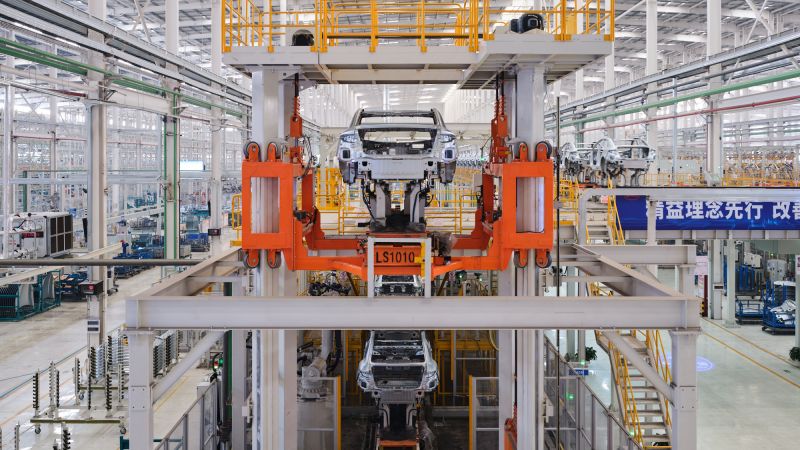Depicting endless rows of uniformed workers, Edward Burtynsky’siconic imagesof mid-2000s Chinese factories spoke to the seemingly inexhaustible human labor behind China’s economic miracle. Just two decades later, the photographer’s glimpse inside an electric car plant near Shanghai presents the opposite phenomenon: a completeabsenceof people.
“This is a factory built by humans but run by robots,” Burtynsky said of the facility, which is owned by top Chinese automaker BYD, on a Zoom call. “I think it’s a foreshadowing of where our future is.”
BYD is at the forefront of a technological revolution. Last year, the company’s annual revenues surpassed American rival Tesla’sfor the first timeas it delivered 4.27 million vehicles (the 1.76 million EVs it produced in 2024 was just short of Tesla’s 1.79 million, but the Chinese company also delivered around 2.5 million hybrid vehicles). Its success is, partly, down to price: BYD’s entry-level model, the Seagull, starts at around $10,000 in China, a fraction of the $32,000 Tesla charges for its least expensive offering, the Model 3. And this affordability is, partly, down to highly automated manufacturing.
In 2023, Burtynsky was granted rare access to a BYD plant in Changzhou, a city about two hours’ drive from Shanghai. He obtained permission through the personal connections of British architect Sir Norman Foster, who wanted a cover image for Domus, a magazine he was guest-editing about the future of various industries, including transportation.
The car giant was, Burtynsky said, “very sensitive” about what he was allowed to document. But he believes he is the first independent photographer to be granted access to one of the company’s factories.
“The humans are really just there to maintain the robots and keep the programs running clean,” he said of the secretive facility, referencing so-called “dark factories,” which are so devoid of human workers they can operate without lights. “Of course, corporations want that. There are no unions, there’s no sick pay and, as long as there’s electricity being fed to (the machines), they can work 24/7.”
The standout image from Burtynsky’s visit, simply titled “BYD Manufacturing Facility #2,” paints a complex picture — not only of rapid change in China but of the ripple effects being felt in supply chains and labor markets around the world.
The image’s “central character,” as the Canadian photographer put it, is an unfinished vehicle on a production line. Columns and beams around it repeat and recede to a vanishing point, producing a mesmerizing symmetry. The factory possessed a “cathedral-esque” quality, he said.
In a sense, though, the photo is the last chapter in a story unfolding thousands of miles away.
The image is part of a wider body of work, called “China in Africa,” exploring what Burtynsky considers to be the “next stage of globalization.” Currently on show at Hong Kong’s Flowers Gallery, the series contrasts BYD’s spotless factory with Chinese-owned rail crossings, warehouses and apparel factories in African countries including Ethiopia.
Taken together, they depict what the photographer called China’s “complete vertical integration, from supply chain to finished product.”
In other words, the human labor he saw in the mid-2000s hasn’t gone — it’s been offshored. And BYD, which is reported to have purchased lithium mines (for battery production) and mineral rights in countriessuch as Brazil, typifies the model, he said.
“They have literally secured their complete supply chain,” he said.
Burtynsky is best known for aerial shots of dramatic landscapes scarred by agriculture and industry, from copper mines to salt pans. Though his images often portray human overexploitation, he considers them to be “fairly neutral.”
“I do it in a sort of deadpan aesthetic,” he said of his photographic style. “I don’t try to lean the viewer one way or the other, in terms of ‘This is bad’ or ‘This is good.’ I’m not trying to manipulate you.”
His photos almost always contain some moral ambiguity. “Without copper,” he offered, illustrating the tradeoff between environmental degradation and human progress, “I couldn’t be having this conversation with you.”
His depiction of BYD’s operations — and automation at large — is arguably even more paradoxical. Car manufacturing may be resource-heavy but electric vehicles could help end our dependance on fossil fuels, making the factories a symbol of environmental recovery, not damage.
What’s more, China may not mourn the loss of jobs that Burtynsky described as “dehumanizing.” And he would know: Long before taking up photography full time, he worked at factories owned by car companies General Motors and Ford. “You feel like you’re part of the machine,” he recalled. “You’re just being used for your human energy because they haven’t (yet) found a machine that can do what you’re doing.”
The enclosed mechanical worlds of his factory photos also differ from his large-scale landscapes, where nature provides the sense of scale. But what unites all of Burtynsky’s work is his attempt to evoke a “sense of wonder.”
“I’m always trying to point my camera into worlds that we’re not all that familiar with, that (invite) the kind of scrutiny that a big, large format print can give you,” he added. “You can jump in and look at the small grease stain on the floor, or some splash of oil on the side of a wall in this pristine plant. You can see these little bits of everyday noise that take it to a more grounded, humanistic level.”
“China in Africa” is currently showing at Flowers Gallery in Hong Kong; “The Great Acceleration” is on at the International Center of Photography in New York City until September 28, 2025.
